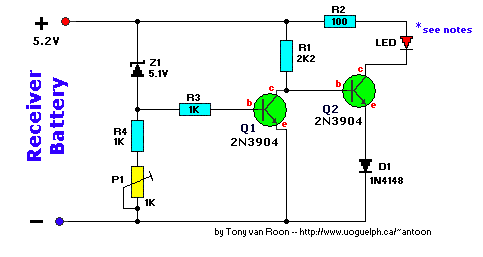Ni-Cad Sensor for Heli
by Tony van Roon

Parts & Description:
R1 = 2K2
R2 = 100
R3 = 1K
R4 = 1K
P1 = 1K, adjustable (trim) potentiometer
Q1,Q2 = 2N3904, PN100, NTE123AP, or equivalent
D1 = Zener diode 5.1Volt (1N4733A, ECG5010A, NTE5010A, etc.)
D2 = Small Signal Diode like the 1N914, 1N4148, NTE519, or ECG519
Led = High- or Ultra Bright 'Jumbo' LED
The above circuit will illuminate an Ultra Bright (preferable a Jumbo-LED) when the Ni-Cad voltage falls below a
preset voltage level. The (Jumbo) Led has to be the Diffused type. This type
seems to be the only desired color and is visible in daylight.
Cut-off point is adjustable with trimpot P1 somewhere between 4.2 and 5.2 volts, depending on your choice of
components. However, I recommend a point between 4.6 - 4.8 volt. Circuit was designed to work with an application I
used for my KALT helicopter, but of course this sensor will work for anything else which use the standard 4.8volt nicad
battery pack. Current draw is approximately 12 mA when the LED is on, standby current is 2mA or less. These specs
are for the red led.
The LED should be mounted where it is visible when the Heli is in-flight (hover). The circuit should be protected
from the usual contaminants like fuel, oil and other dirt. Heat shrink and silicon adhesive are an excellent choice.
Parts are not critical but keep resistor tolerance at 5% or less.
I noticed that some types of Ultra- or High brightness Led's have their 'flat' side as anode instead of kathode so if
you don't see any action from the led, just reverse. In general, the short leg or flat side of a led is the kathode.
No damage will occur if the led is connected the wrong way.
Back to Gadgets Page
Copyright © Tony van Roon

